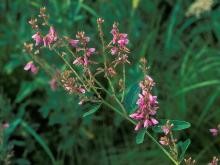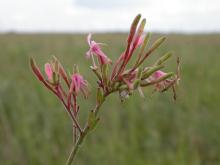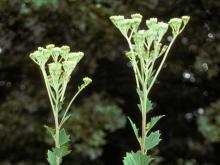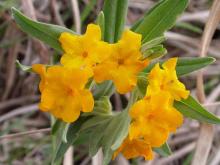Wildflowers, Grasses and Other Nonwoody Plants
Media

Species Types
Scientific Name
Amsonia illustris
Description
Often found on gravelly Ozark streamsides, shining blue star lifts its clusters of showy, light-blue flowers in late spring. A top choice for native wildflower gardening, it is interesting spring, summer, and fall.
Media

Species Types
Scientific Name
Conyza canadensis (formerly Erigeron canadensis)
Description
Horseweed looks something like a goldenrod, except that the tiny composite flowers are not yellow. Instead, they are cream-colored and rather drab. In Missouri, this plant is especially associated with disturbed habitats and is a troublesome crop weed.
Media

Species Types
Scientific Name
Blephilia ciliata
Description
Square, unbranching stems, opposite leaves, two-lipped flowers, and a mild minty fragrance are clues Ohio horsemint is in the mint family. Tight, rounded flower clusters are stacked atop one another at the stem tips.
Media

Species Types
Scientific Name
Desmodium spp. (17 species in Missouri)
Description
Missouri has 17 species of tick trefoils, which live in a variety of habitats. Hikers know them well from their chains of hairy little seedpods that stick to clothing like parasites!
Media

Species Types
Scientific Name
Oenothera filiformis (formerly Gaura longiflora, G. biennis)
Description
Large-flowered gaura is a tall plant whose white flowers turn pinkish as they age. Four petals point upward, then bend back, and 8 stamens droop downward. The flowers look something like small butterflies.
Media

Species Types
Scientific Name
Arnoglossum atriplicifolium (also Cacalia atriplicifolia)
Description
The stout, smooth leaves of pale Indian plantain, with their glaucous-white coating beneath, look almost artificial. They are irregularly shaped, with pointed lobes. At the base of the plant, they can be 6 inches wide. They become gradually smaller up the stem.
Media

Species Types
Scientific Name
Cuscuta spp.
Description
Dodders are easy to identify, even though at first you might not recognize them as plants. These parasitic plants usually look like a hairlike mass of yellow or orange, leafless, wiry, vining stems wrapping around the stems of other plants.
Media

Species Types
Scientific Name
Lithospermum canescens
Description
Hoary puccoon's small, tubular flowers arise on spirally condensed stalks that uncoil and elongate as more flowers open toward the tip. Occurs nearly statewide in prairies, glades, pastures, roadsides, and other open areas.
See Also
About Wildflowers, Grasses and Other Nonwoody Plants in Missouri
A very simple way of thinking about the green world is to divide the vascular plants into two groups: woody and nonwoody (or herbaceous). But this is an artificial division; many plant families include some species that are woody and some that are not. The diversity of nonwoody vascular plants is staggering! Think of all the ferns, grasses, sedges, lilies, peas, sunflowers, nightshades, milkweeds, mustards, mints, and mallows — weeds and wildflowers — and many more!





















